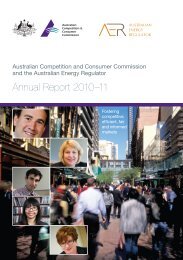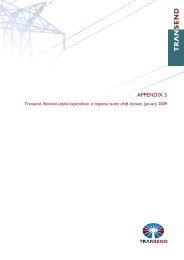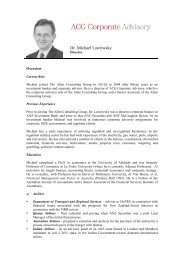Internal consistency of risk free rate and MRP in the CAPM
Internal consistency of risk free rate and MRP in the CAPM
Internal consistency of risk free rate and MRP in the CAPM
Create successful ePaper yourself
Turn your PDF publications into a flip-book with our unique Google optimized e-Paper software.
firms <strong>in</strong> order to arrive at an estimate <strong>of</strong> <strong>the</strong> <strong>risk</strong> <strong>of</strong> <strong>the</strong> reference service relative to <strong>the</strong><br />
market (beta).<br />
161. The second methodology may not be entirely forward look<strong>in</strong>g if it takes an estimate <strong>of</strong><br />
relative <strong>risk</strong> (beta) from historical data. Do<strong>in</strong>g so assumes that <strong>in</strong>vestors believe that<br />
<strong>the</strong> equity <strong>in</strong> question will behave <strong>in</strong> <strong>the</strong> same way, <strong>and</strong> <strong>in</strong> <strong>the</strong> same relationship to <strong>the</strong><br />
market, as it did <strong>in</strong> <strong>the</strong> historical beta estimation period. This is only reasonable if<br />
<strong>in</strong>vestors believe that future shocks to <strong>the</strong> economy/equity markets will largely be <strong>the</strong><br />
same (<strong>in</strong> type, frequency <strong>and</strong> magnitude) as <strong>the</strong> shocks experienced over <strong>the</strong> historical<br />
beta estimation period. This may or may not be a reasonable assumption.<br />
162. However, under this methodology, <strong>the</strong> estimate <strong>of</strong> relative <strong>risk</strong> is applied to a forward<br />
look<strong>in</strong>g <strong>MRP</strong> estimate. By do<strong>in</strong>g so <strong>the</strong> estimate will capture prevail<strong>in</strong>g conditions <strong>in</strong><br />
<strong>the</strong> market for funds <strong>in</strong> general. Provided <strong>the</strong> prevail<strong>in</strong>g relative <strong>risk</strong> <strong>of</strong> <strong>the</strong> reference<br />
services (e.g. beta) is consistent with <strong>the</strong> historically estimated value <strong>the</strong>n this will<br />
result <strong>in</strong> an estimate that is commensu<strong>rate</strong> with prevail<strong>in</strong>g conditions <strong>in</strong> <strong>the</strong> market for<br />
funds for providers <strong>of</strong> <strong>the</strong> reference services.<br />
163. Similar issues are associated with <strong>the</strong> application <strong>of</strong> <strong>the</strong> DGM whe<strong>the</strong>r it be applied to<br />
<strong>the</strong> market or a subset <strong>of</strong> comparable firms. However, to <strong>the</strong> extent <strong>the</strong> market as a<br />
whole is less likely to have prices affected by liquidity issues this may render <strong>the</strong><br />
results from <strong>the</strong> market estimate less volatile due to this factor.<br />
7.2.1. Application<br />
164. I estimate a prevail<strong>in</strong>g market cost <strong>of</strong> equity at 12.28% <strong>and</strong> <strong>MRP</strong> at 8.52%. This is<br />
based on <strong>the</strong> AMP method us<strong>in</strong>g end December 2011 dividend yields from <strong>the</strong> RBA,<br />
long run dividend growth <strong>of</strong> 6.6% nom<strong>in</strong>al <strong>and</strong> an assumption that each dollar <strong>of</strong><br />
dividend delivered to <strong>in</strong>vestors comes with 11.125 cents value <strong>of</strong> frank<strong>in</strong>g credits. 53<br />
Assum<strong>in</strong>g a beta <strong>of</strong> 0.8 <strong>and</strong> <strong>risk</strong> <strong>free</strong> <strong>rate</strong> <strong>of</strong> 3.77% as at 31 December 2012 this gives<br />
a cost <strong>of</strong> equity for <strong>the</strong> reference services <strong>of</strong> 10.58%.<br />
165. By way <strong>of</strong> contrast, Bloomberg, us<strong>in</strong>g analysts forecasts <strong>of</strong> near term dividend growth<br />
<strong>and</strong> its own model <strong>of</strong> transition <strong>and</strong> steady state growth, estimates <strong>the</strong> prevail<strong>in</strong>g<br />
market cost <strong>of</strong> equity at 14.1% <strong>and</strong> <strong>MRP</strong> <strong>of</strong> 10.5% as at end-December 2011.<br />
7.3. Methodology iii)<br />
166. Compared to <strong>the</strong> first <strong>and</strong> second methodologies <strong>the</strong> third methodology relies on<br />
historical average data. An historical average estimate <strong>of</strong> <strong>the</strong> cost <strong>of</strong> equity can be a<br />
reliable proxy for <strong>the</strong> prevail<strong>in</strong>g cost <strong>of</strong> equity if <strong>the</strong> cost <strong>of</strong> equity is stable through<br />
time. The evidence exam<strong>in</strong>ed <strong>in</strong> this report demonst<strong>rate</strong>s that movements <strong>in</strong> <strong>risk</strong><br />
premiums <strong>and</strong> CGS yields tend to ‘cancel’ each o<strong>the</strong>r out with <strong>the</strong> cost <strong>of</strong> equity<br />
53 Based on <strong>the</strong>ta <strong>of</strong> 0.35 <strong>and</strong> 75% <strong>of</strong> dividends be<strong>in</strong>g franked.<br />
Competition Economists Group<br />
www.CEG-AP.COM<br />
44







